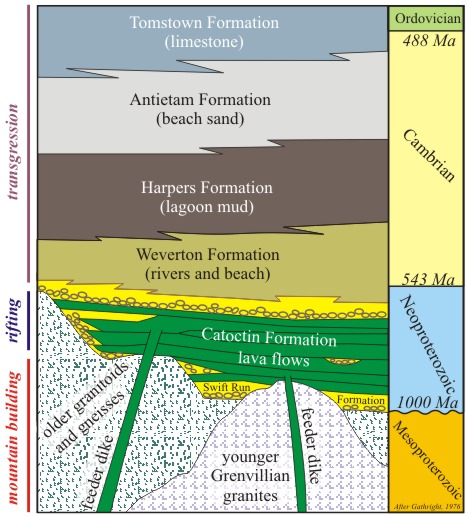The Grenville Orogeny, responsible for Virginia’s basement complex, was one mountain-building event among many that helped put together a Mesoproterozoic supercontinent called Rodinia. But Rodinia didn’t last: it broke apart during the Neoproterozoic to form the Iapetus Ocean basin. This rifting event is recorded in Virginia’s Blue Ridge province in the Swift Run Formation and the Catoctin lava flows.
It’s probably about time to start putting some of these rock units in stratigraphic context. Here’s my redrawing (and updating) of a cartoon Shenandoah National Park stratigraphic column based on an original by Tom Gathright (1976):

You’ll notice here that the Swift Run Formation is interbedded with the Catoctin Formation, a Neoproterozoic series of lava flows fed by fissure eruptions (kind of like what’s happening this week in Iceland).
Trickling downhill away from these fissure eruptions would have been flows of basaltic lava (tholeitic, indicating a mantle source chemistry). If you want a warmer modern analogue than Iceland, look to the Afar Triangle region of Ethiopia:

As with Neoproterozoic Virginia, the continental crust of modern Ethiopia is stretching, opening up topographic grabens which are being filled with clastic influx from the surrounding highlands and mafic lava which is formed from decompression melting in the underlying mantle, and funneled to the surface via feeder dikes. In places you will see streambed conglomerates interlayered with the mafic lava flows, and in places there are tuffs and rhyolites that are a (volumetrically-small) part of the package. Elsewhere there are lake sediments. The two bear a common geologic signature, despite being separated by thousands of miles and half a billion years. There’s that refrain again: Same as it ever was, same as it ever was.
Once on the surface, the lava cooled, and in some places, columnar jointing formed:
The cooling age on some of the rhyolitic upper units in the Catoctin Formation is 570-565 Ma (Rb/Sr on pyroxene by Badger and Sinha, 1988). Some mafic and felsic dikes (could be feeders) associated with the unit yield the same age via U/Pb (Aleinikoff and others, 1995).
At some point, ancestral North America (“Laurentia”) drifted away from the spreading center, and volcanism ceased. The crust cooled, subsided, and then a sequence of sedimentary rocks began to accumulate atop the cooled lava flows. This transgressive sequence of sediments (the Chilhowee Group) is the next thing up in the stack. More on that later.


0 thoughts on “Transect debrief 3: Rodinian rifting”